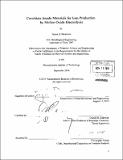| dc.contributor.advisor | Donald R. Sadoway. | en_US |
| dc.contributor.author | Paramore, James D | en_US |
| dc.contributor.other | Massachusetts Institute of Technology. Dept. of Materials Science and Engineering. | en_US |
| dc.date.accessioned | 2011-05-09T15:19:57Z | |
| dc.date.available | 2011-05-09T15:19:57Z | |
| dc.date.copyright | 2010 | en_US |
| dc.date.issued | 2010 | en_US |
| dc.identifier.uri | http://hdl.handle.net/1721.1/62687 | |
| dc.description | Thesis (S.M.)--Massachusetts Institute of Technology, Dept. of Materials Science and Engineering, 2010. | en_US |
| dc.description | Cataloged from PDF version of thesis. | en_US |
| dc.description | Includes bibliographical references (p. 61-63). | en_US |
| dc.description.abstract | Molten oxide electrolysis (MOE) has been identified by the American Iron and Steel Institute (AISI) as one of four possible breakthrough technologies to alleviate the environmental impact of iron and steel production. This process has also been identified by the National Aeronautics and Space Administration (NASA) as a means to produce oxygen gas, as well as iron and silicon raw materials on the Moon. MOE produces iron by electrolysis of an iron oxide containing electrolyte. The electrolysis results in the production of pure iron metal at the cathode and pure oxygen gas at the anode. Because of the low vapor pressure of the electrolyte at temperatures above 1538°C, MOE can be performed above the melting temperature of iron. The production of liquid metal, ready for continuous casting, is a prerequisite for any industrial-scale extractive metallurgical process. Therefore, if an inert anode can be identified, MOE could provide a an industrial process to produce iron from its ore with pure oxygen gas as the only direct emission. The feasibility of MOE as a carbon-neutral process hinges on the identification of an inert anode material. Therefore, the scope of this study was to determine the criteria of an inert anode for MOE, identify candidate materials, and evaluate the performance of these materials. Previous studies of MOE at MIT found iridium, a platinum group metal, to be an excellent candidate for an inert anode. The high cost of iridium makes it an unlikely candidate for a commercial iron production process. However, iridium provides a likely candidate for lunar production of oxygen, or high-purity iron production. Furthermore, the use of iridium on the laboratory-scale provides a widely available inert anode material to facilitate the study of other areas of MOE. Therefore, unique anode morphologies were evaluated as a means to reduce the economical strain of using an iridium anode. In addition to iridium, a wide array of readily available, high-temperature electrode materials were tested. Due to the highly corrosive environment of MOE, none of the readily available materials tested are compatible with the process. It is believed that the most likely candidate for an inert anode lies in an engineered material, composed of a refractory substrate and an oxide passivation layer. Therefore, the criteria for such a material were determined and likely candidates are discussed. | en_US |
| dc.description.statementofresponsibility | by James D. Paramore. | en_US |
| dc.format.extent | 63 p. | en_US |
| dc.language.iso | eng | en_US |
| dc.publisher | Massachusetts Institute of Technology | en_US |
| dc.rights | M.I.T. theses are protected by
copyright. They may be viewed from this source for any purpose, but
reproduction or distribution in any format is prohibited without written
permission. See provided URL for inquiries about permission. | en_US |
| dc.rights.uri | http://dspace.mit.edu/handle/1721.1/7582 | en_US |
| dc.subject | Materials Science and Engineering. | en_US |
| dc.title | Candidate anode materials for iron production by molten oxide electrolysis | en_US |
| dc.title.alternative | Candidate anode materials for iron production by MOE | en_US |
| dc.type | Thesis | en_US |
| dc.description.degree | S.M. | en_US |
| dc.contributor.department | Massachusetts Institute of Technology. Department of Materials Science and Engineering | |
| dc.identifier.oclc | 714386000 | en_US |
